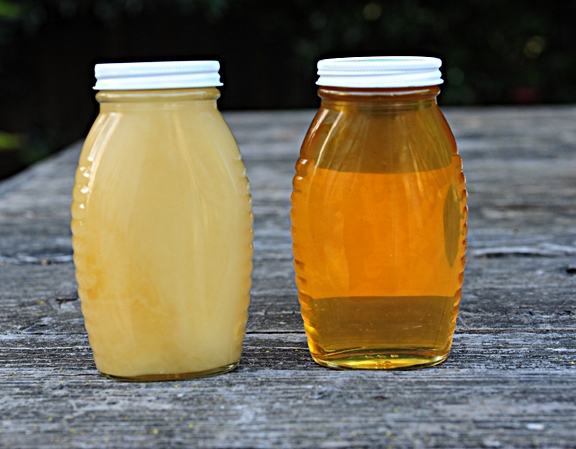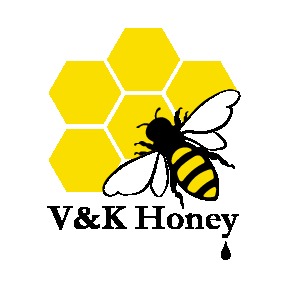“Help! My honey has crystallized!”
One of the most frequent comments I get from people at the Farmers Markets I attend is regarding honey that has crystallized. The emotion behind those comments range from disappointment to disgust to confusion.
To start with, honey crystallizing is a totally normal occurrence! Your honey has not gone “bad”, it hasn’t spoiled and there is absolutely nothing wrong with it! Honey that has been properly “cured” has a low moisture content and the natural properties of honey prevent the risk of any pathogen surviving or multiplying that would harm or cause discomfort to any human over the age of 1 year old. Solutions this high in sugar just naturally harden and crystallize. There is nothing wrong with your honey, and in fact, you can use it in this form if you like! This is a great way to use it on toast or sandwiches, as it is less likely to drip or run off/out of it and down your arm! We even make and sell a product that is made through controlled crystallization called Creamed Honey. There isn’t any reason at all that you can’t enjoy crystallized honey just as much as the liquid form. BUT, if you really prefer or require it be in a flowing liquid form, you can, with these tips and some patience, have your honey go back to being liquid with most or all of the good flavor and healthful properties preserved.
Honey is a “super saturated sugar solution”. Bees collect floral nectar, bring it back to the hive, and through a process of using their body heat and fanning their wings, it evaporates most of the moisture out of the nectar leaving behind the sugars that can sustain the caloric needs of the colony over the winter. Because of honey’s low moisture and high sugar content, it is completely normal for those sugars to crystallize at room temperature. The rate at which the honey crystallizes varies greatly and is dependent on the types of sugar in the nectar the original nectar that makes the honey and to an extent, the temperature where it is stored. For example, one type of nectar that makes a honey with a very long life in the liquid form is tupelo. On the other end of the spectrum, oil seeds like canola and sunflower are very difficult for beekeepers to extract because they can crystallize in days or even less!
The warmth inside a bee colony keeps or returns honey stored in the comb to a liquid form, and we can do the same. During winter in our northern climate, bees eat the stored honey that has been stored in cells throughout the combs in the hive. When temperaturs drop, to conserve heat, the bees cluster up onto a ball. In the process, they heat the honey in proximity to them, liquefying it so that it is easier to consume. Bees can use solid sugars as food, but first they need to use their saliva or moisture gathered from inside the hive to make it into a form that their tongues can ingest. The properties of honey make it a perfect food source during cold months because it will return to a liquid state with heat. Knowing those properties can be helpful to us at being able to pour or spoon it from a jar into our drinks or food.
We can use heat to reliquify honey, but we also know that TOO much heat is bad! It is bad for a lot of the properties of honey such as the flavor, the aroma, naturally occurring enzymes and color. So how much is too much? There is a lot of debate is on this subject, but my opinion is that the bees keep the honey in it’s best natural form, and the temperature in the hive is the optimal temperature to retain those desirable properties. The optimal temperature in a bee hive is about 95° F, (35° C) Knowing that helps us determine the best temperature to return our honey to it’s preferred liquid state.
So how do you reliquify your crystallized honey? Opinions and methods are extremely varied. While some of those methods aren’t “wrong”, some of them destroy some of the properties of honey that you may find desirable. Here are some of those methods:
Microwave heating- My advice? Don’t do it! Microwaves heat inconsistently, meaning some parts of the honey in the container will get extremely hot, while other parts aren’t affected at all. Heat destroys flavor, aromas, and delicate enzymes in the honey that you might like to be in there. If your honey came in a plastic bottle, some of the chemicals used in the manufacturing of that bottle may be released with high heat into your honey and ingested many of which could be poisonous. While these things may not concern you, another property of microwaving should keep anybody from using this method is moisture content. Because microwaves heat so inconsistently, and parts of the honey in the bottle get very hot, very quickly, they are apt to evaporate water from the honey. While honey needs to be below a certain moisture threshold to preserve its antibacterial nature, too low moisture means it can no longer be in a liquid state. Put another way, you dehydrate the honey down to its sugars and solids, you will be making it impossible to ever become liquid again.
Heating water on the stove While not as bad as microwaving, heating honey above hive temperature is less than ideal. If you use this method, I would recommend heating a pot of water on the stove and removing the heat before putting your jar of honey in the water. Even a moderate amount of flame or heat kept on your kettle can result in temperatures that can melt plastic or boil over. Monitor it closely and only keep the honey in the heat as long as necessary. While you may be heating honey in the recipe you are making, the LONGER you heat it, the MORE of the flavor you will lose! Even in baked goods, there is a difference between using good tasting honey and honey with inferior flavor. Ideally, you would want your water you are using to heat the honey to be as consistently near, or slightly above hive temperature to retain the most flavor. You can use a thermometer to accomplish this.
Kitchen sink This is the method I recommend to people because it is the easiest and requires the least equipment. All you need to do is turn on your faucet at your kitchen sink to the hot side. Let it run until the water coming out is the max temperature you can get from your faucet. This will vary based on the set point temperature of your water heater. Now adjust the temperature of the water with the faucet handle(s) until you can keep your hand in the stream without having to take it out because it’s too hot. This temperature is usually around 110° F (43° C). If you are able to, or are concerned about flavor, aroma, and enzymes, you can use a thermometer to verify this. Stopper up your sink, set the honey jar (cover on) in the sink and fill it with water to the level of the honey in the jar. Just let it sit there until the water in the sink is cold. You may have to do this more than once to get it to be completely liquid again.
While the honey in the jar warms, the temperature in the sink will drop as time passes. Honey is not a great conductor of heat, so it will take some time before the temperature reaches a point where it could possibly damage it, but in the mean time, the temperature of the water in the sink has dropped to levels that won’t cause that damage. The key to using this method is patience!!
Souse vide If you are an avid cooking enthusiast or cook as your profession, you may have one of these at your disposal. If so, it is a spectacular way to liquefy your honey! Immerse the heating element into a pot or vessel of water you plan to use for this process and set the temperature to 95° F (35° C). Once the water is up to temp, place the honey jar with the lid on in the water until it is liquid again. How much easier can that get? Check progress frequently and remove it from the heat as soon as possible after the honey has reached the state you desire. You may want to set a timer to intervals of 5-15 minutes so you don’t forget once it nears the end.
Adding water Don’t! Unless you plan on using the honey that day, adding water allows bacteria, mold, and yeast to multiply in honey, and it will go bad. Unless you are making mead (honey wine), those results can be disastrous, taste and smell horrible, and/or make you sick. I have from time to time, had that tiny bit of crystallized honey in a bottle that I didn’t want to waste. In that instance, I used the hot water I was using for tea poured into the jar and swished around until it dissolved the honey right before I dumped it straight into my tea-cup. Be careful and know what you are doing if you ever add water to honey!!
I hope this article was helpful, and you get the most enjoyment from your honey!
If you have any further questions, feel free to ask or comment below!
Paul

